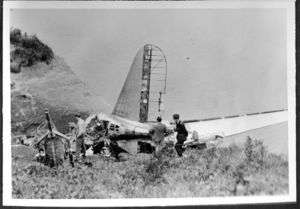VR-HDG
Contents
History
This aircraft was delivered to the USAAC on June 21, 1944. She arrived at Brisbane on July 29 the same year and was then sent to the Foreign Liquidation Commission at Tacloban in the Philippines for disposal. She was sold to Cathay Pacific on March 15, 1947, was valued at HK$268,321 at the company's takeover by Swire the following year, and was written off in a crash at the Braemar Reservoir, Hong Kong on February 24, 1949. The aircraft, captained by Johnny Paish, had approached Kai Tak's runway 07 in thick fog and, although the pilot could see the runway from the Hung Hom beacon, he subsequently lost visual contact and elected to turn right and circle to land on runway 31. Losing sight of the airfield again, whist heading downwind for this landing, Captain Paish carried out a 'missed approach' straight towards Hong Kong Island. The aircraft struck the lip of the Braemar Reservoir at a height of 400 feet, broke up and caught fire. All on board were killed.
The crew were Captain J C Paish; First Officer A Campbell; Radio Officer N W F Moore and Flight Hostess Olive Batley
Eric Price, Taipan of Butterfield & Swire at the time sent a telegram to Jock Swire, Chairman of John Swire & Sons, in London as soon as he heard the news "Aircraft from Manila crashed here foggy hillside above harbour circling after sighting airfield subject enquiry apparently human error details later." The next day he produced this fuller report for London. "The aircraft was on her way back from Manila with a quite unusually large complement of passengers. The weather was brilliant to within the outskirts of the Colony but on and within the circle of hills there was heavy but patchy cloud and mist. The pilot, who was one of the soundest and most experienced of our men, asked for permission to come in after a long wait. This was granted by the Kai Tak Control on condition that visibility was 3 miles. The aircraft came in safely, saw Stonecutters Island from near Lantao, and when approaching Stonecutters reported to Air Control that he was able to see the airfield and asked for permission to land on a certain runway. Immediately after this was granted he corrected his request and obtained permission to land on another runway. To do this involved circling; in the course of this he ran into heavy cloud which covered all the hills behind Causeway Bay and Lei Yue Mun, and the next news was of an aircraft at low altitude heard to crash in the neighbourhood of the main Taikoo reservoir. The aircraft is a burnt out wreck and all the occupants must have been killed instantly. From all the facts we have, it is a case of human error ...."


